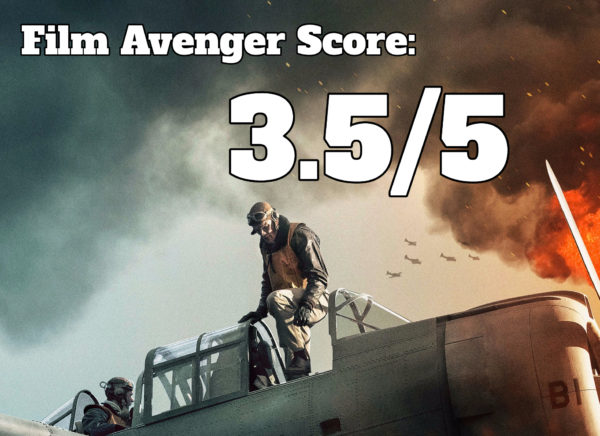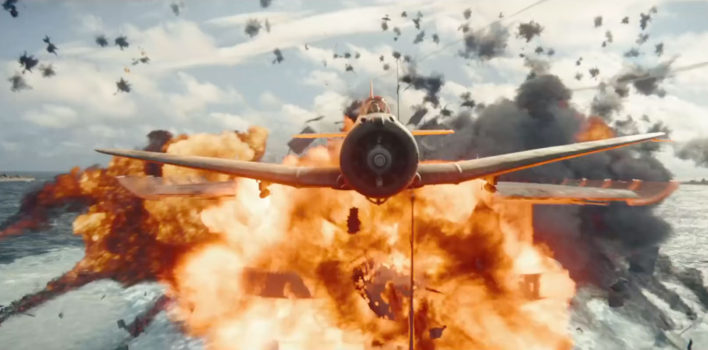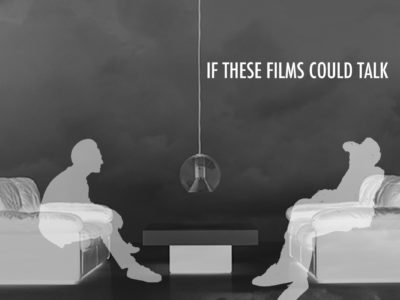Review| Midway (2019): Profiles of Bravery
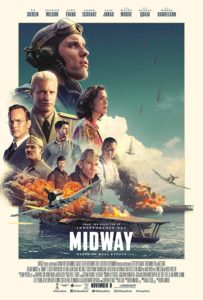 The Second World War is one of my favorite historical eras, and I will always give most films set in that time period a look – even if I know there’s a huge possibility that they are going to be bad.
The Second World War is one of my favorite historical eras, and I will always give most films set in that time period a look – even if I know there’s a huge possibility that they are going to be bad.
When I had heard that director Roland Emmerich was making his own film about the Battle of Midway, the turning point in the Pacific Theater, I was filled with trepidation to say the least. While I do have a soft spot for Independence Day and The Patriot, Emmerich has been very sketchy with his last few films. They have gone into overwhelming schlock territory (Independence Day: Resurgence) and insulting, one-dimensional cartoon action (White House Down).
Much to my surprise, I enjoyed Midway a lot. It was Emmerich back to form—creating an exciting spectacle without any schlock or political pandering. It was an engaging film that made history come alive. And the history buff in me also appreciated how true to the actual events the film stayed.
Midway and similar films set in the WWII era bring with them depictions of varying degrees of heroism, valor, and bravery. It was a reminder just what real brave men looked like and just how much our current culture has corrupted the meaning of the word.
SPOILERS AHEAD! WELL, THE ALLIES WON WWII, SO…
The Good: A Historical Retelling
 It seemed that Roland Emmerich had channeled his earlier efforts directing Midway. Though there was much excitement and action, it was very subdued when compared to Emmerich’s previous films like 2012 and Independence Day: Resurgence—films steeped in wanton destruction porn with little regard for the human element.
It seemed that Roland Emmerich had channeled his earlier efforts directing Midway. Though there was much excitement and action, it was very subdued when compared to Emmerich’s previous films like 2012 and Independence Day: Resurgence—films steeped in wanton destruction porn with little regard for the human element.
The perspective from which Emmerich chose to tell this story was also surprising: a very “just-the-facts” sort of retelling with very little cinematic flair—and it worked exceptionally well. All of the major events the film covers (Pearl Harbor, the Doolittle Raids, and the titular battle) were seen from interesting viewpoints, as if we were one of the grunts getting only bits and pieces of information. The Pearl Harbor attack began suddenly because that is how it actually happened. I also appreciated that all the key players were the actual heroes and not fictionalized amalgamations. Emmerich simply let the story play out as it happened, making the drama and action that much more astonishing.
Just like how there was little cinematic build-up to the battles, there wasn’t a lot of rousing bombast and fanfare, either musically or visually, when killer blows were inflicted upon the Japanese fleet by the American forces during the fighting. This was surprising at first, given that I sort of enjoyed that side of Emmerich’s style (see the original Independence Day). But this new direction really worked for this story.
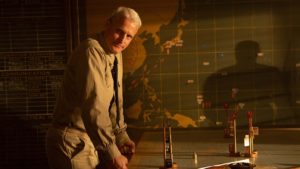 There were some epic sweeping shots of those battles, but they were used sparingly, especially when it came to the perspectives of the characters. The little moments of celebration were subtle—as they probably would have been in the moment—such as when Admiral Nimitz was told that the Americans had won at Midway. It was a quiet moment without much pomp because the brass knew that this was only the opening salvo in a much longer and bloodier campaign. A sobering and realistic choice.
There were some epic sweeping shots of those battles, but they were used sparingly, especially when it came to the perspectives of the characters. The little moments of celebration were subtle—as they probably would have been in the moment—such as when Admiral Nimitz was told that the Americans had won at Midway. It was a quiet moment without much pomp because the brass knew that this was only the opening salvo in a much longer and bloodier campaign. A sobering and realistic choice.
Midway was a very different film stylistically from, say, Michael Bay’s Pearl Harbor, which I do enjoy on certain levels, or Christopher Nolan’s Dunkirk, which is a masterpiece of the genre. Midway is a more compelling narrative than the former and has less cinematic flair than the latter. But that just made it a different animal. It was more akin to a docudrama than a stylistic cinema piece, and that’s okay when it comes to retelling history.
The Bad: Effects and Time
Where both Pearl Harbor and Dunkirk one-up Midway was in the realm of visual effects. Most of the film, particularly the battle scenes, were filmed on green screens in Montreal, and there are a few scenes that definitely showed it. The compositing made it look fake.
Pearl Harbor, for all its explosions and stylistic bombast, had a sense of realism to it because there were shots of actual planes flying and ships in the real locations. Dunkirk was even shot on the actual beach on which the evacuation took place. Midway, in places, looked like a plastic world—a video game. Not all of the shots were like this, but the ones that were were very distracting.
Emmerich stated that the use of green screen and CGI was done because he wanted to make this film as authentic as possible and there were virtually no aircraft carriers or battleships from the era that haven’t been modified in some way (turned into museum ships, for example). So I can at least respect the reason for the CGI.
Lastly, Midway was a good film, but an additional 20 to 30 minutes would have made it better. The film would have benefitted from more time with the characters. Given the story the film needed to tell in the time alotted, it seemed like a lot of the quiet character moments were whittled down considerably. We didn’t really get to spend a lot of time with the main players, which created an emotional disconnect. The extra time could have also rounded out the battle sequences. The film was very good at setting up the battles, but the aftermath was rushed through, especially Pearl Harbor and Midway itself.
To Be Brave
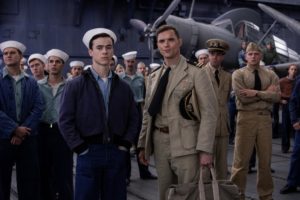 Seeing film depictions of real-life battles like Midway often fills me with a great sense of humility and awe. Those men on the ships and in the skies were just ordinary men, but they possessed within them the extraordinary spirit to fight in the face of overwhelming danger and possible death. Some faced death head-on. Others came back maimed and scarred for life—both mentally and physically.
Seeing film depictions of real-life battles like Midway often fills me with a great sense of humility and awe. Those men on the ships and in the skies were just ordinary men, but they possessed within them the extraordinary spirit to fight in the face of overwhelming danger and possible death. Some faced death head-on. Others came back maimed and scarred for life—both mentally and physically.
I can only hope that, if I were in that situation, I would have had the courage to do the same thing. I cannot even imagine such a situation, and that is to their credit. I am free and live in a free country because of their bravery.
To be courageous and brave is not the absence of fear, but acting in spite of it. We all experience fear, but when we take that first step anyway, we become brave and grow. And being brave for the right reasons also matters.
“So do not fear, for I am with you. do not be dismayed, for I am your God. I will strengthen you and help you; I will uphold you with my righteous hand.” Isaiah 41:10
Fear and bravery come up often in the Bible. In fact, one of the phrases God uses most in both the Old and New Testaments is telling humanity not to be afraid. Biblical heroes like Moses, Abraham, and David were reassured by God when facing danger. When God took on human form in the face of Jesus, there were many instances when the Lord told His disciples, as well as others around Him, not to fear.
 God tells us to be brave for one reason: God is in control. In every instance of God telling someone not to fear, the rationale given is because, ultimately, God is sovereign. With His power and might, He can see us through our darkest times, empowering us to do things and reach heights we never thought we could. He’s not saying that it will be easy or that we will reach the end unscathed, but He says we will emerge stronger for listening to Him and not listening to our own fears.
God tells us to be brave for one reason: God is in control. In every instance of God telling someone not to fear, the rationale given is because, ultimately, God is sovereign. With His power and might, He can see us through our darkest times, empowering us to do things and reach heights we never thought we could. He’s not saying that it will be easy or that we will reach the end unscathed, but He says we will emerge stronger for listening to Him and not listening to our own fears.
But far more than any human examples, Jesus modeled bravery for us all. He courageously faced death because He knew that God was with Him and He was sacrificing Himself for the good of all humanity. Because He was as much human as He was God, he must have felt fear during His execution. But he endured the cross and rose again. His bravery and courage saved literally everyone from an eternity away from God.
True courage and bravery, the kind that matter eternally, are found in following Jesus. He holds us up above the water and tells us not to be afraid. With Christ, there is nothing in this world that can destroy us. This does not mean that we will not be singed in the process, but that Jesus will see us through the fire.
“In this world you will have trouble. But take heart! I Have overcome the world.” John 16:33
Jesus told us to be brave, and we must rediscover what being brave really means.
The Last Word
Midway is Roland Emmerich’s best film in years. Though big on action and spectacle, it is, at its core, a humble and pure retelling of historical events with actual drama emerging organically without the need for cinematic pomp and bluster. I think that Emmerich should do more films like this; he may have found his niche.
World War II brought out both the best and worst of humanity. The best came in the form of brave men willing to run toward danger and death to protect their families and their nation. True bravery comes from following Jesus, no matter what dangers befall us. The culture has misunderstood what it means to truly be brave when all we really have to do is look to the cross.
And one more thing: thank a veteran whenever possible. Their sacrifice gives us the ability to live our lives in relative peace and security.
